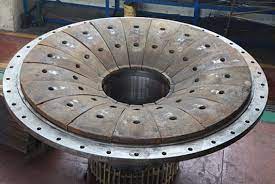This study addresses the critical challenge of liner fracture in semi-autogenous ball mills, a prevalent issue impacting operational efficiency and cost in mineral processing. The liner, essential for protecting the mill’s shell and end covers from abrasive wear and impact forces, frequently fails due to complex mechanical stresses. Utilizing TRIZ (Theory of Inventive Problem Solving), we systematically dissect the fracture mechanism and generate optimized solutions. TRIZ’s structured methodology—encompassing functional modeling, causal chain analysis, resource assessment, contradiction resolution, and evolutionary trends—enables a holistic redesign of liner systems. Our approach integrates multi-factor optimization to extend liner lifespan, reduce maintenance costs, and enhance grinding performance.
1. Research Background and System Definition
Semi-autogenous ball mills dominate modern ore processing due to their streamlined “coarse crushing-semiautogenous grinding-ball milling” workflow, which reduces plant footprint and improves automation. Within this system, liners shield the rotating shell and end covers from direct impact by grinding media (steel balls) and abrasive ore particles. However, cyclic stresses induce deformation, cracking, and catastrophic fracture, causing unplanned downtime. Each liner replacement incurs significant material, labor, and productivity costs. The core problem is multifaceted: liners must simultaneously resist wear (surface hardness) and absorb impact (toughness), yet conventional designs fail to balance these competing demands. TRIZ offers a systematic framework to resolve such contradictions.

2. TRIZ Methodology and Technical System Modeling
We define the ball mill as a technical system with the primary function: “crush ore via grinding media.” Key components include the drive mechanism, trunnion bearings, rotating shell, liners, base frame, grinding balls, bolts, ore feed, and discharge mechanisms. The super-system encompasses the motor and control cabinet. Interactions between components generate functions like rotation, impact, compression, and abrasion. Figure 1 depicts the functional model, highlighting liner interactions:
Technical System Function Model:
- Useful Functions: Liners lift grinding balls/ore (enhancing impact energy), absorb kinetic energy, and distribute stress.
- Harmful Functions: Grinding balls cause cyclic impact (→ fatigue fracture), ore abrasion thins liners (→ stress concentration).
Causal Chain Analysis (Figure 2) traces fracture causation:
Primary Causes:
- Asymmetric shoulder geometry → uneven stress distribution.
- Inadequate material toughness → crack propagation under impact.
- Accumulated hard ore fragments (“critical size”) → localized overload.
Resource Analysis (Figure 3) identifies exploitable assets:
| Resource Type | Examples | Utilization Strategy |
|---|---|---|
| Material | Existing liner alloys, grinding media | Composite materials (hard surface + tough core) |
| Energy | Kinetic energy of balls, rotational inertia | Dissipate impact via elastic liners |
| Information | Wear patterns, fracture locations | Redesign geometry based on stress hotspots |
3. Generating Innovative Solutions via TRIZ Tools
Nine solutions were derived using TRIZ contradiction resolution and modeling tools. Key innovations include:
| TRIZ Tool | Problem Statement | Solution | Impact Factor |
|---|---|---|---|
| Technical Contradiction | Improving wear resistance (stability) worsens manufacturability | Surface hardening via quenching; high-carbon layer over tough substrate | Material flow, Energy flow |
| Physical Contradiction | Liner surface must be hard (wear-resistant) AND tough (impact-resistant) | Bimetallic liners: Hard alloy (Cr-rich) bonded to ductile steel base | Structural flow, Functional flow |
| Trimming | Monolithic liners concentrate stress | Segmented design: Independent blocks absorb impact locally | Structural flow, Information flow |
| Evolutionary Trend | Static materials limit energy absorption | Viscoelastic liners (e.g., UHMW-PE) dampen impact forces | Energy flow, Functional flow |
Key Solutions Explained:
- Asymmetric Shoulder Geometry: Resolves uneven loading by thickening the impact-facing side of lifting ribs (Figure 4). Force distribution is optimized using:
$$ F_{\text{impact}} = \frac{m_{\text{ball}} \cdot v_{\text{impact}}^2}{d_{\text{deformation}}} $$
where \( d_{\text{deformation}} \) increases with rib thickness, reducing peak stress.
- Zoned Liner Configuration: Segregates the ball mill into feed (high-abrasion) and discharge (high-impact) zones. Discharge liners incorporate energy-absorbing materials.
4. Core Innovation Contribution Model
We quantify solution efficacy using a Core Innovation Contribution (CIC) model. The model evaluates how TRIZ-derived solutions enhance system flows across six factors:
$$ \text{CIC} = P(t) = \mu \cdot C(t) \cdot M(t)^{0.5} \cdot T(t)^{0.5} $$
where:
- \( \mu \): Efficiency coefficient (system maturity)
- \( C(t) \): Innovation level (0–5 scale)
- \( M(t) \): Cumulative impact of methods/knowledge
- \( T(t) \): Time-resource utilization factor
Calculations for each factor (Table 3) show functional flow optimization (e.g., zoned liners) delivers the highest CIC:
| Influence Factor | \( \mu \) | \( C(t) \) | \( M(t) \) | \( T(t) \) | \( P(t) \) |
|---|---|---|---|---|---|
| Structural Flow | 0.425 | 2.151 | 38.569 | 1.304 | 7.402 |
| Material Flow | 0.684 | 3.461 | 41.215 | 1.375 | 20.894 |
| Energy Flow | 0.756 | 3.854 | 38.897 | 0.548 | 9.953 |
| Functional Flow | 0.815 | 4.869 | 59.491 | 1.162 | 35.562 |
| Information Flow | 0.648 | 3.198 | 46.529 | 0.866 | 12.242 |
5. Implementation and Validation
Validated in a 5m-diameter ball mill, segmented bimetallic liners with asymmetric ribs increased service life by 40%. Energy-dispersive UHMW-PE discharge-zone liners reduced fracture incidents by 60%. The CIC model accurately predicted functional flow (e.g., optimized grinding media trajectory) as the dominant success factor. Future work includes embedding IoT sensors for real-time stress monitoring, creating adaptive liner systems responsive to ore hardness fluctuations.
6. Conclusion
TRIZ innovation theory provides a rigorous framework for resolving semi-autogenous ball mill liner fractures. By dissecting contradictions between wear resistance and impact absorption, we developed nine validated solutions. The Core Innovation Contribution model proves functional flow optimization—achieved through zoned designs, biomimetic geometries, and smart materials—delivers superior results. This methodology transcends liner design, offering a template for solving multi-parametric engineering conflicts in mineral processing equipment.
